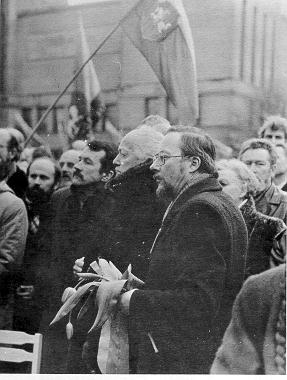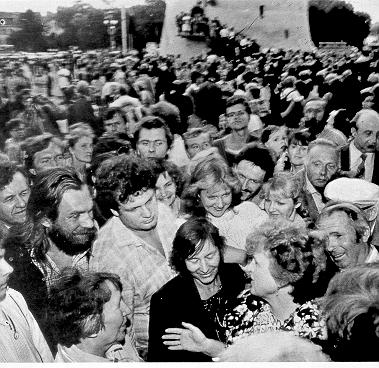Editor of this issue: Antanas V. Dundzila
Copyright © 1990 LITUANUS Foundation, Inc.

|
LITUANUS
LITHUANIAN
QUARTERLY
JOURNAL
OF ARTS
AND SCIENCES
Volume 36, No.2 -
Summer 1990
Editor of this issue: Antanas V. Dundzila ISSN 0024-5089
Copyright © 1990 LITUANUS Foundation, Inc. |
 |
FOR INDEPENDENCE
A momentous event for the Lithuanian nation occurred on March 11, 1990. By unanimous vote, newly elected representatives declared the restoration of the free, independent Republic of Lithuania. The declaration, which was proclaimed in the capital city of Vilnius, followed the first freely held elections during 50 years of continuing occupations.
The declaration was no small task for a country that is still occupied by the Soviet Union. It was made in the face of Mr. Gorbachev's recent mixture of threats and veiled promises. Everyone understands that the declared restoration is yet to be practically achieved.
The moral of this Lithuanian action is that an idea, especially the idea of liberty and independence, is much more durable than the armor of war machines or the fetters of spiritual and physical oppression. In Lithuania this idea has survived half a century of intensive brainwashing.
The credit for this practical manifestation of a victorious idea belongs fully to the people of Lithuania. Ever since the Soviet ultimatum of June 14, 1940, Lithuanians resisted the sequential occupations of the Soviets, the Nazis, and the Soviets again. The resistance, which took many forms, cost the country dearly. However, it was this resistance which helped to keep the idea alive.
In the free world, the Lithuanian cause was significantly supported by the policy of some nations, the United States in particular, of non-recognition of Lithuania's incorporation into the Soviet Union. As a result of such a policy, the Lithuanian Diplomatic Service was active in the Lithuanian cause throughout this time. Significantly, on March 11th, the day of the Lithuanian declaration, the White House immediately issued a very positive statement on Lithuania's behalf.
Within the past several years, the Baltic States have embarked on what in 1989 was formally stated as the Baltic Way. This parliamentary route toward the peaceful restoration of statehood for Lithuania, Latvia, and Estonia, while guaranteeing the rights of all nationalities in the Baltic republics, would seek freedom, democracy, and economic progress. By publicly declaring their independence, Lithuanians left no doubt that they wanted democracy and justice peacefully, but now—a way of life denied to them for half a century.
For their help in preparing this special issue, LITUANUS is grateful to the Lithuanian Legation and the Lithuanian Information Center in Washington, D.C. Our kind thanks also to staff and volunteers.

Prof.
Vytautas Landsbergis (with glasses) the newly elected
President of the Supreme Council of the Republic of Lithuania, at
the Lithuanian Independence commemoration on February 16, 1989.
Next to him stands his father, a retired architect, Lithuanian
civic leader and statesman. The 97-year-old Vytautas Landsbergis
was decorated for his service in the 1918 Lithuanian war for
independence; in the summer of 1941, after the Lithuanian revolt
against the Soviets, be served as a minister 'm the Lithuanian
Provisional Government.

Crowds with Kazimiera Prunskienė in Vilnius, August 23, 1989, the
anniversary
of the Molotov-Ribbentrop Pact. On March 11, 1990, Prunskienė
was elected the Prime Minister of the restored Republic of
Lithuania. She is referred to as the Iron Lady of Lithuania.
Photo R. Urbakavičius